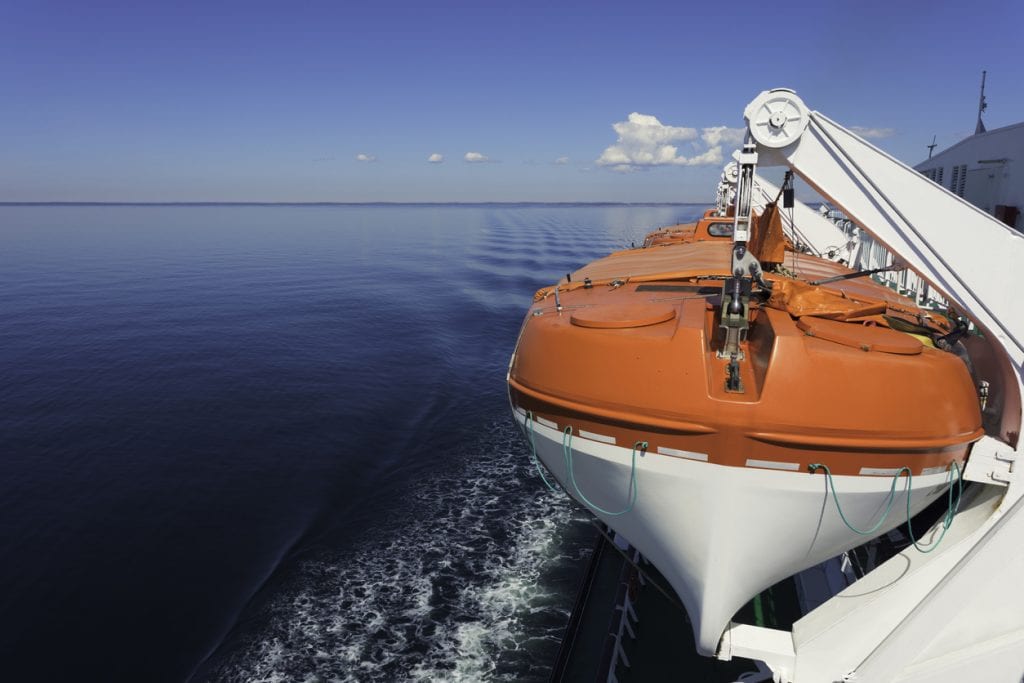Introduction

© Drago Brdar
ShipSpotting.com
Since the SOLAS mandated introduction in 1986 of ‘on-load’ release hooks, numerous crew member injuries and many deaths have been suffered during the emergency drill launching and retrieval of davit mounted lifeboats. The accident depicted in the thumbnail image appears to be a davit winch failure and not an ‘on-load’ hook failure. However, it serves to illustrate the potential for sudden tragedy. This MM Risk Bulletin is therefore focused on raising MM member awareness of the very serious ‘on-load’ release hook problem. The precautions necessary to fully protect crew safety during obligatory SOLAS and Flag State lifeboat drills are also discussed.
Background to ‘off-load’ and ‘on-load’ release hooks
There are two main types of release hooks for davit launched lifeboats, being the ‘off-load’ hook and the ‘on-load’ hook. The original ‘off-load’ hook is of 19th century design. It was intended to permit manual release only when the lifeboat was fully waterborne and all weight was off the davit block hooks. It was simple and worked well if a lifeboat was launched in more or less perfect conditions i.e. from a vessel stopped in calm seas. Such placid conditions rarely exist when abandoning ship and this resulted in numerous accidents and fatalities while attempting to disconnect the ‘off-load’ hooks.
The high incidence of ‘off-load’ hook accidents motivated the creation of the ‘on-load’ release hook and the phasing in of its SOLAS mandated utilisation. The ‘on-load’ hook was designed to allow the lifeboat crew to release both davit hooks simultaneously before the boat was fully waterborne in either calm or heavy seas and even if the launching vessel had not come to a full stop. The provision of these capabilities required complex engineering to accomplish with up to 88 different designs being tested and ultimately approved by the IMO.
Subsequent to a large number of ‘on-load’ hooks being retrofitted on board SOLAS Convention vessels, serious accidents began to be reported as a consequence of the inadvertent release of these new design hooks during both drills and real emergencies. Investigation by the UK’s Maritime Accident Investigation Bureau (MAIB) and other organisations showed that the principal cause in most cases was human error compounded by the complexity of the release hook system and inadequate crew training. A number of significant design, installation and maintenance issues were also identified.
What type of ‘on-load’ release hooks must now be fitted?
The aforementioned investigative process resulted in what might be described as an IMO ‘recall and upgrade’ as stipulated by MSC.1/Circ.1392. This required that all of the original, or Mark 1*, ‘on-load’ release hooks that had been installed to be subjected to a mandatory evaluation by the manufacturer. It also required that all Mark 1 ‘on-release’ hooks be either upgraded or replaced with Mark 2* ‘on-load release hooks to MSC.1/Circ.1392 standards. Finally, it required that Fall Preventer Devices (FPDs) be fitted to lifeboats until such time as the ‘on load’ release hooks were upgraded or replaced and then tested as being compliant with the Life Saving Appliance (LSA) Code as amended by MSC.320(89).
As of 1 July 2019, Mark 2 ‘on-load’ release hooks (now termed ‘Release and Retrieval Systems’ by the IMO) are required to be fitted to all davit launched lifeboats on board all vessels regulated by SOLAS 1974 as amended i.e. to all vessels over 500 GT trading internationally. Certification must be carried onboard to prove compliance to both Flag and Port State Control authorities.
*Note: The terms Mark 1 and Mark 2 have been used by MM in this Risk Bulletin to clearly differentiate between the design and installation of ‘on-load’ release hooks before (Mark 1) and after (Mark 2) the mandatory provisions of MSC.1/Circ.1392 and the LSA Code as amended. These terms are not used by the IMO or contained in SOLAS.
Are ‘on-load’ release hook accidents still happening?
Despite the positive action taken by the IMO to overcome the Mark 1 ‘on-load’ release hook design and maintenance problems by upgrading to Mark 2 versions, lifeboat accidents are still being reported on a regular basis. Examples during 2019 to date include two tanker crew members lost off the US East Coast in Feb 2019 when a lifeboat unexpectedly released and dropped into the sea. This was followed by two fatalities on board a Shell drilling rig during a lifeboat drill in the Gulf of Mexico in June 2019. It is likely that other cases have not been reported to the media and probably many more that should have been reported internally as ISM Code ‘near misses’.
‘On-load’ release hook operation and hazards
One of the ‘on-load hook hazard examples provided by the MAIB is the failure of the ship’s crew to properly reset the ‘on-load’ hooks after completing a lifeboat launch and hook release drill. The underlying cause was found to be that the crews involved had never been trained how to reset an ‘on-load’ hook. Nor did they understand the danger of an unexpected release if they failed to do so. Regrettably, inadequate crew awareness and training in ‘on-load’ hook operation continues today to present a serious hazard to crew safety. In addition, the numerous designs and types of approved ‘on-load’ hooks in use have made the dangers associated with these release devices even more difficult to eradicate.
Conclusion and Takeaway
It can be seen that although the Mark 1 ‘on-load’ release hook design and installation has been upgraded to IMO Mark 2 standards, not all the problems associated with the original design and use of these units have been resolved. As a consequence, they must still be operated and maintained with the utmost caution and in strict accordance with the manufacturer’s instructions. This work should also be accomplished either by or under the close supervision of senior shipboard personnel who have a clear understanding of the ‘on-load’ release system as fitted and its associated dangers.
MM recommends its members refer to the BIMCO publication titled ‘Avoid Lifeboat Accidents’. Published in 2017, it contains an easy to read and understand guide to both ‘on-load’ and ‘off-load’ release systems, inclusive of high quality photos and diagrams. MM encourages all members to alert their ship managers and Masters to this publication with a view to motivating the shipboard inspection of all davit fitted ‘on-load’ release systems and their safety assessment. Reference documents for this purpose include by MSC.1/Circ.1392., the LSA Code as amended by MSC.320(89)., and the BIMCO publication, ‘Avoid Lifeboat Accidents’. All ISM Code/SMS procedures’ non-conformities relating to equipment standards, maintenance and operation should be identified, reported and then rectified as a matter of the highest priority. LSA crew training manuals should also be amended as necessary.


